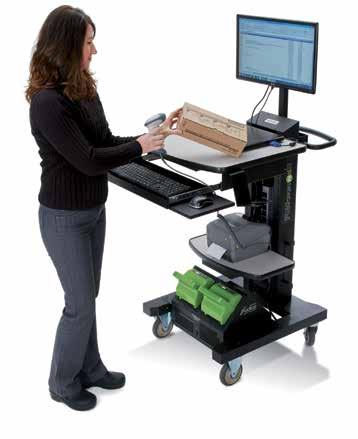
4 minute read
Mobile technology in the warehouse
Warehouse workers are wasting a significant amount of hours moving back and forth to printers and computers. Keith Bland at Datanet presents a new solution.
The average warehouse employee wastes seven weeks every year with unnecessary motion. “It’s easy to underestimate how much time is spent walking back and forth to printers, computers and other equipment. Ten seconds here or there equates to a costly practice over the course of a year,” Keith Bland, Director of Sales at Datanet says.
According to Keith, eliminating just eight minutes of unnecessary walking per hour for each worker, can save thousands of dollars.
In a warehouse environment printing stations are often placed around the outside of a warehouse, where the power and Ethernet supply is. More recently workstations have moved closer to the activity by putting cable and power through the columns of the warehouse. However, this is still nowhere near as efficient as it can be, Keith says.
“Organisations have recognised that having workstations away from the activity is reducing efficiency and productivity. In recognition of this there’s been a few solutions, firstly moving the workstation closer to say a column that supports the roof. But this still isn’t close enough to the activity. Secondly, some organisations introduced Sealed Lead Acid (SLA) batteries solutions to make the workstation mobile. While the SLA
battery creates a mobile workstation, it is usually a big heavy battery and needs to be charged for a significant time.”
Datanet, an Enterprise Mobility solution provider, is bringing a new mobile workstation product to Australia. “We know that this wasted time in walking from a print station and back to the area of activity is costing logistics organisations a significant amount of money so we knew there needed to be a better solution available in the market,” Keith says.
The Newcastle Systems Mobile Picking Cart is the first of its kind. It uses the PowerSwap Nucleus lithium battery which provides eight to 12 hours of power time. When one charge is In a warehouse, printing stations should be as close to the picking activity as possible, Keith Bland says.
depleted, the battery can be swapped with a fully charged one in a matter of seconds.
“This is the first swappable lithium power system on the market for industrial environments. The battery is light and easy to remove,” Keith says. The battery weighs as little five kgs and operates a plug and play system. “There is no tools, heavy lifting or maintenance personnel required for battery changes,” Keith explains.
There are also added safety benefits to being able to have the printing stations where the activity is taking place. “It’s better to limit workers having to move around the warehouse, particularly with forklifts and as automated guided vehicles are more commonly found. If you can limit workers interaction with these kinds of vehicles then you can create a safer environment.”
According to Keith, this kind of technology will be well-received in the Australian logistics market and Datanet has already taken orders from industry leading companies including Amazon, Roy Hill, Honda and ASICS.
The feedback from Amazon so far has been great, with a spokesperson stating that the portable power enables them to take workstations to any area within the facility while increasing workflow, productivity and offering greater flexibility in the process.
In an environment like Amazon, where peak times require a 24/7 operation knowing that the workstation is flexible and will be able to offer a full shift of power is crucial to efficiency, Keith says.
The mobile picking carts are manufactured in the US by Newcastle Systems and Datanet will be the exclusive distribution partner for the products here in Australia. ■
BRING YOUR SUPPLY CHAIN LOGISTICS TOGETHER
As a market leader in major global trade lanes, C.H. Robinson’s customisable suite of global logistics services and technology solutions serve all your transportation needs, under one roof.

Discover how our experience and scale create uniquely better outcomes at www.chrobinson.com
October 31 st The Glasshouse Melbourne
1 50+ Supply Chain and Logistics Professionals Speakers include: Australia’s Leading Supply Chain Technology Networking and Thought Leadership Exchange.
Anthony Laye Mentalist Amanda Stevens Consumer Futurist









Eddie Capel President and CEO. Manhattan Associates. Dan Gregory Behavioural Strategist
and many more
Technology Sessions include: Retail Fulfilment Technology / Warehouse Robotics and Automation / WES vs WCS vs WMS / Order Management / Demand Forecasting and Inventory Optimisation / RFID / Android Handheld Technology / Voice Picking









